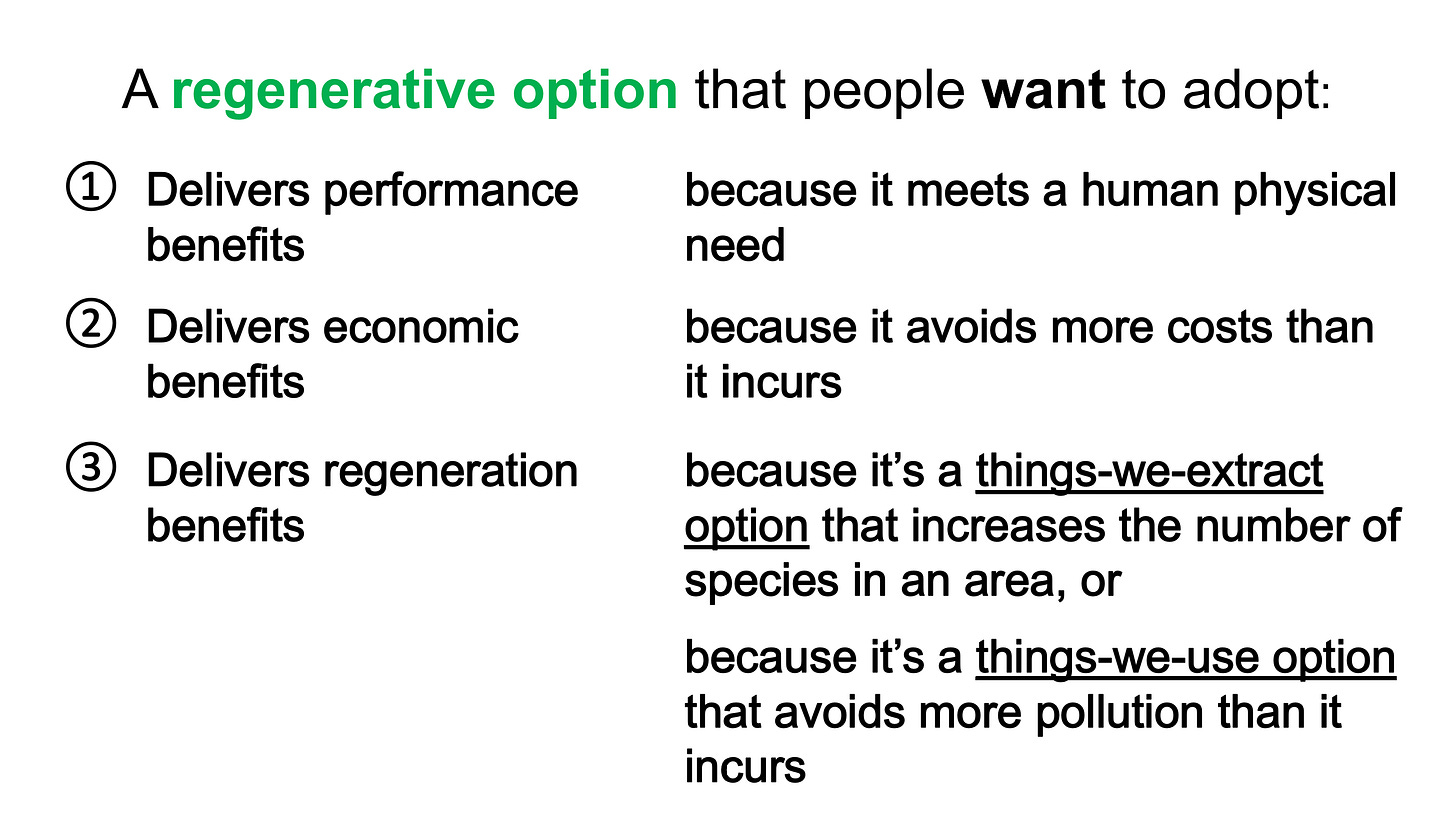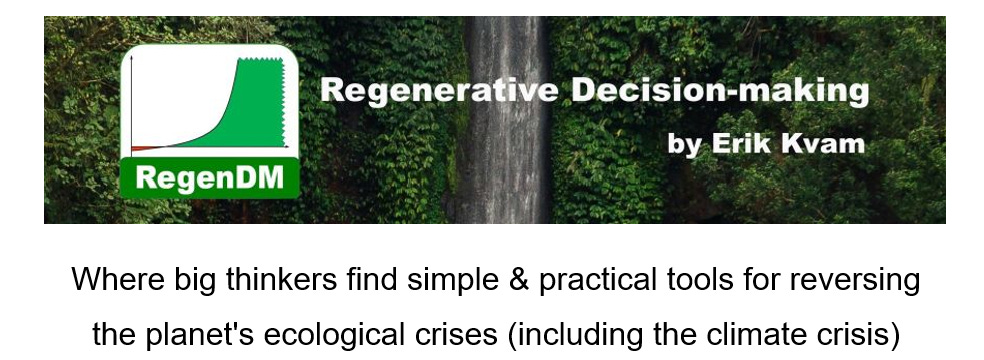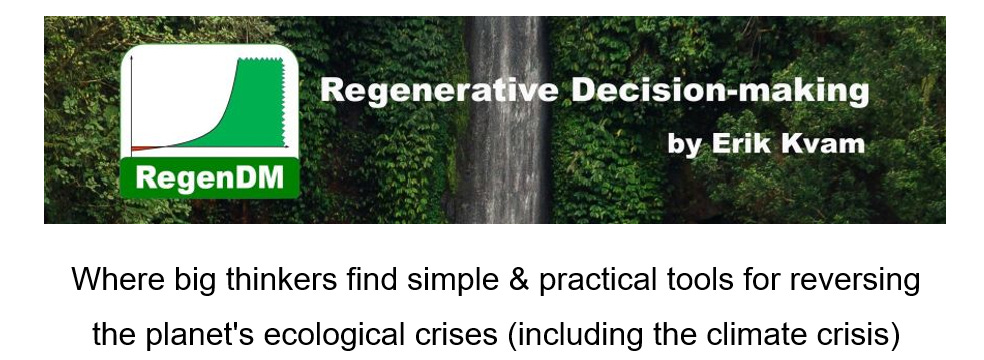Extremely Simple Decision-making for Adopting Regenerative Options
Part 5 of the “Picture-Guide” Series
An option allows its user to get more upside than downside as [the user] can select among the results what fits [the user] and forget about the rest.
– Nassim Nicholas Taleb
In Part 3 of this “Picture-Guide” series, you learned how people everywhere want to adopt extremely simple “regenerative options” that deliver extremely simple performance benefits, economic benefits and regeneration benefits …
In Part 4 of this series, you learned that people everywhere persuading themselves to adopt regenerative options are going to demand a new & extremely simple kind of information services – called “regenerative information services” – for evaluating and comparing the performance benefits, economic benefits and regeneration benefits of options for meeting human physical needs …
What might a decision-making process look like through which people everywhere persuade themselves what options they want to adopt and decide to adopt regenerative options?
Such a decision-making process – usable by decision-makers everywhere – might look like a simple four-step “regenerative decision-making process.”
Through a simple regenerative decision-making process:
First, decision-makers identify options for meeting their human physical needs:
Second, decision-makers use regenerative information services to evaluate the performance benefits, economic benefits and regeneration benefits of those options:
Third, decision-makers use regenerative information services to compare those benefits:
Fourth, decision-makers persuade themselves what options they want to adopt and decide to adopt regenerative options:
Regenerative decision-making – through a regenerative decision-making process -- allows people everywhere to simply & practically reverse the planet’s eco-crises because regenerative decision-making extremely simplifies their decision-making for adopting regenerative options.
Regenerative decision-making extremely simplifies people’s decision-making because – through regenerative decision-making -- people everywhere persuade themselves what options they want to adopt and decide to adopt regenerative options.
Regenerative decision-making extremely simplifies their decision-making for adopting regenerative options because regenerative decision-making delivers “optionality” to people everywhere in the form of regenerative options.
What is “optionality”?
Here’s how Nassim Nicholas Taleb, the author of Antifragile, defines “optionality”:
Optionality is the property of asymmetric upside (preferably unlimited) with correspondingly limited downside (preferably tiny).
Regenerative decision-making delivers “optionality” to people everywhere in the form of regenerative options that deliver more upside than downside in the form of:
performance benefits (because the regenerative option meets a human physical need)
economic benefits (because the regenerative option avoids more costs than it incurs), and
regeneration benefits (because the regenerative option is a “things-we-extract” option that increases the number of species in an area, or it’s a “things-we-use” option that avoids more pollution than it incurs).
Regenerative decision-making delivers “optionality” to people everywhere and extremely simplifies their decision-making for adopting regenerative options because, in the words of Nassim Nicholas Taleb:
If you “have optionality”, you don’t have much need for what is commonly called intelligence, knowledge, insight, skills, and these complicated things that take place in our brain cells. For you don’t have to be right that often. All you need is the wisdom to not do unintelligent things to hurt yourself (some acts of omission) and recognize favorable outcomes when they occur.
An option allows its user to get more upside [in the form of performance, economic & regeneration benefits] than downside as [the user] can select among the results what fits [the user] and forget about the rest.
Optionality extremely simplifies the user’s decision-making because all the user has to do is “recognize favorable outcomes [more upside than downside] when they occur.”
The user doesn’t “have to be right that often” because the user doesn’t “have much need for what is commonly called intelligence, knowledge, insight, skills, and these complicated things that take place in our brain cells [like awareness of one’s cognitive biases]” to decide what’s best for the user.
Optionality extremely simplifies the user’s decision-making because a decision-maker “can select among the results [benefits delivered by regenerative options] what fits [the user] and forget about the rest.”
The user is making the user’s own choices of what’s best for the user. No one is telling the user what options the user should choose or must choose.
Optionality extremely simplifies the user’s decision-making because the user’s regenerative decision-making does not depend on – and is not encumbered by – political economic decision-makers deciding what’s best for the user.
To recap …
… extremely simple “regenerative options” that deliver extremely simple performance benefits, economic benefits and regeneration benefits …
… plus extremely simple regenerative information services for evaluating and comparing the performance benefits, economic benefits and regeneration benefits of options for meeting human physical needs …
… equals people everywhere using extremely simple regenerative decision-making for persuading themselves what options they want to adopt and deciding to adopt regenerative options …
Regenerative decision-making allows people everywhere to simply & practically reverse the planet’s eco-crises because it delivers “optionality” to people everywhere and extremely simplifies their decision-making for adopting regenerative options.
If you can find a simpler and more practical decision-making process – usable by people everywhere – for reversing the planet’s ecological crises (including the climate crisis), please let me know.
In the next article of this “Picture-Guide” series, you will learn how to design and use an extremely simple Observe – Orient – Decide – Act loop (an “OODA loop”) – usable by people everywhere – for adopting regenerative options at the exponential rate needed to reverse the planet’s ecological crises (including the climate crisis) as a whole.
I’m super grateful for your likes, replies and shares.
Thank you for reading and aloha!
P.S. I cross-posted this article on Medium for greater reach.














